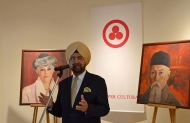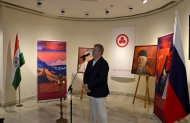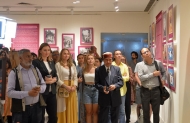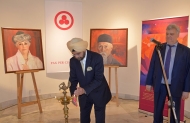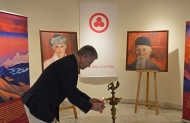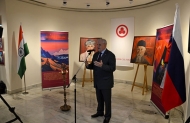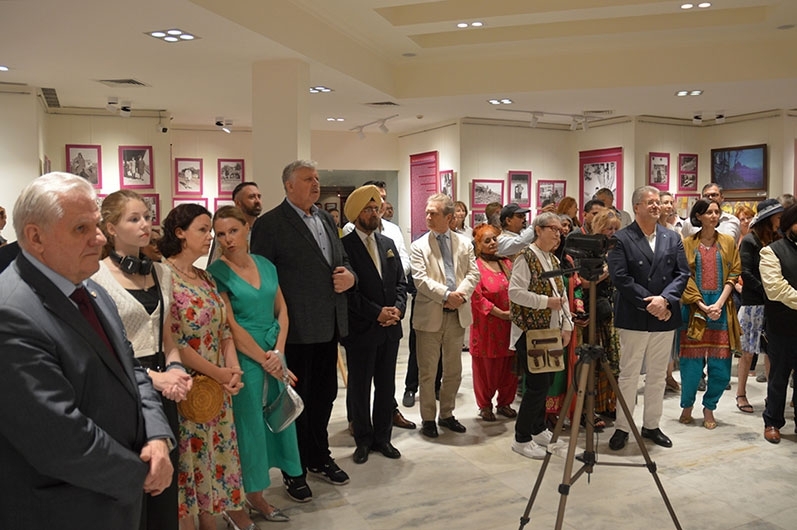
The exhibition “The Master’s Universe”, dedicated to the anniversary of Nicholas Roerich, opened in New Delhi at the Russian House.
The exhibition includes more than 150 paintings, reproductions and photographs from the personal archive of the Roerichs. It was prepared by the International Center of the Roerichs together with the Russian House in New Delhi, the Russian Embassy in India, the international union of non-governmental organizations "Eurasian Peoples' Assembly", the SCO National Center for Public Diplomacy, and the International Roerich Memorial Trust in Naggar.
Alexander Stetsenko, vice-president of the International Center of the Roerichs, Andrey Belyaninov, Secretary General of the Eurasian Peoples' Assembly and Stanislav Korolev, Director of the SCO National Center for Public Diplomacy in Russia, spoke at the opening of the exhibition. In their speeches, they emphasized the importance of the artistic, scientific and philosophical heritage of Nicholas Roerich for world culture, and expressed confidence that this event would become a powerful impetus for a new round in the development and strengthening of Russian-Indian relations.
One day, the creative activity of Nicholas Roerich attracted the attention of Jawaharlal Nehru. In 1942, he came to the artist’s estate in the Himalayas with his daughter Indira. Future Indian leaders spent several days talking with Roerich, and this event lies at the heart of cultural cooperation between the peoples of Russia and India.
Later Jawaharlal Nehru, Prime Minister of India said:
“When I think about Nicholas Roerich, I am amazed at the scope and richness of his activity and creative genius. A great artist, a great scientist and writer, an archaeologist and explorer, he touched and illuminated so many aspects of human endeavor. The sheer quantity is amazing - thousands of paintings, and each of them is a great work of art. When you look at these paintings, many of which depict the Himalayas, you seem to capture the spirit of these great mountains that have towered over the plains of India for centuries and have been our guardians. His paintings remind us of much of our history, our thinking, our cultural and spiritual heritage, much not only of the past of India, but also of something permanent and eternal, and we feel that we are indebted to Nicholas Roerich, who revealed this spirit in his magnificent canvases.”
At one time, Nehru’s daughter, Indira Gandhi, Prime Minister of India, emphasized that Roerich’s work is a connecting thread between the two countries:
“His wonderful paintings amaze with their richness and subtle sense of color and, above all, wonderfully convey the mysterious grandeur of the nature of the Himalayas. And he himself, with his appearance and nature, seemed to be to some extent imbued with the soul of the great mountains. He was not verbose, but he exuded a restrained power that seemed to fill the entire surrounding space... We also value him as a link between the Soviet Union and India.”
Researchers call one of the peak moments in the life and work of Nicholas Roerich the creation of cultural institutions in America, the Central Asian expedition of 1924–1928 - the largest in the twentieth century, the preparation and signing of the first ever agreement on the protection of cultural objects, known as the Roerich Pact, which became the basis international legal system in the field of protection of cultural heritage.
In letters to Roerich, the famous Indian writer, poet, composer, artist and public figure Robindranath Tagore wrote: “I have vigilantly followed your great humanistic work for the benefit of all peoples, for whom your Peace Pact with its banner for the protection of all cultural treasures will be extremely effective symbol. I am sincerely glad that this Pact has been accepted by the League of Nations, and I deeply feel that it will have enormous consequences for the cultural understanding of peoples."
As the leader of the Eurasian Peoples' Assembly Andrei Belyaninov noted at the opening of the exhibition in India, it is difficult to overestimate the importance of the Peace Pact - it later formed the basis of modern UNESCO documents on the protection of cultural heritage.
Guests of the event had the opportunity to get acquainted with the exhibition during an excursion. Visitors to the exhibition from Russia and India did not remain indifferent to what they saw: a bright and large-scale exhibition, including reproductions of paintings by Nicholas Roerich, opened the gates to the Master’s Universe, and each participant was able to touch its priceless treasures that evening.



